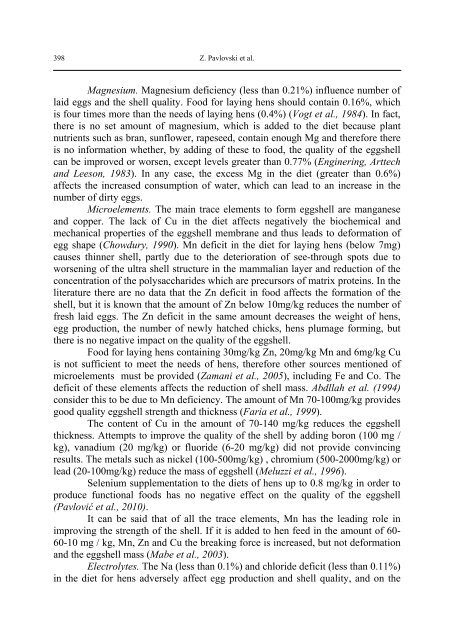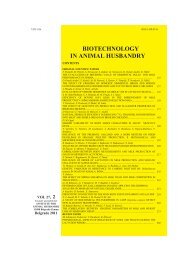Biotechnology in Animal Husbandry - Institut za Stočarstvo
Biotechnology in Animal Husbandry - Institut za Stočarstvo
Biotechnology in Animal Husbandry - Institut za Stočarstvo
You also want an ePaper? Increase the reach of your titles
YUMPU automatically turns print PDFs into web optimized ePapers that Google loves.
398<br />
Z. Pavlovski et al.<br />
Magnesium. Magnesium deficiency (less than 0.21%) <strong>in</strong>fluence number of<br />
laid eggs and the shell quality. Food for lay<strong>in</strong>g hens should conta<strong>in</strong> 0.16%, which<br />
is four times more than the needs of lay<strong>in</strong>g hens (0.4%) (Vogt et al., 1984). In fact,<br />
there is no set amount of magnesium, which is added to the diet because plant<br />
nutrients such as bran, sunflower, rapeseed, conta<strong>in</strong> enough Mg and therefore there<br />
is no <strong>in</strong>formation whether, by add<strong>in</strong>g of these to food, the quality of the eggshell<br />
can be improved or worsen, except levels greater than 0.77% (Eng<strong>in</strong>er<strong>in</strong>g, Arttech<br />
and Leeson, 1983). In any case, the excess Mg <strong>in</strong> the diet (greater than 0.6%)<br />
affects the <strong>in</strong>creased consumption of water, which can lead to an <strong>in</strong>crease <strong>in</strong> the<br />
number of dirty eggs.<br />
Microelements. The ma<strong>in</strong> trace elements to form eggshell are manganese<br />
and copper. The lack of Cu <strong>in</strong> the diet affects negatively the biochemical and<br />
mechanical properties of the eggshell membrane and thus leads to deformation of<br />
egg shape (Chowdury, 1990). Mn deficit <strong>in</strong> the diet for lay<strong>in</strong>g hens (below 7mg)<br />
causes th<strong>in</strong>ner shell, partly due to the deterioration of see-through spots due to<br />
worsen<strong>in</strong>g of the ultra shell structure <strong>in</strong> the mammalian layer and reduction of the<br />
concentration of the polysaccharides which are precursors of matrix prote<strong>in</strong>s. In the<br />
literature there are no data that the Zn deficit <strong>in</strong> food affects the formation of the<br />
shell, but it is known that the amount of Zn below 10mg/kg reduces the number of<br />
fresh laid eggs. The Zn deficit <strong>in</strong> the same amount decreases the weight of hens,<br />
egg production, the number of newly hatched chicks, hens plumage form<strong>in</strong>g, but<br />
there is no negative impact on the quality of the eggshell.<br />
Food for lay<strong>in</strong>g hens conta<strong>in</strong><strong>in</strong>g 30mg/kg Zn, 20mg/kg Mn and 6mg/kg Cu<br />
is not sufficient to meet the needs of hens, therefore other sources mentioned of<br />
microelements must be provided (Zamani et al., 2005), <strong>in</strong>clud<strong>in</strong>g Fe and Co. The<br />
deficit of these elements affects the reduction of shell mass. Abdllah et al. (1994)<br />
consider this to be due to Mn deficiency. The amount of Mn 70-100mg/kg provides<br />
good quality eggshell strength and thickness (Faria et al., 1999).<br />
The content of Cu <strong>in</strong> the amount of 70-140 mg/kg reduces the eggshell<br />
thickness. Attempts to improve the quality of the shell by add<strong>in</strong>g boron (100 mg /<br />
kg), vanadium (20 mg/kg) or fluoride (6-20 mg/kg) did not provide conv<strong>in</strong>c<strong>in</strong>g<br />
results. The metals such as nickel (100-500mg/kg) , chromium (500-2000mg/kg) or<br />
lead (20-100mg/kg) reduce the mass of eggshell (Meluzzi et al., 1996).<br />
Selenium supplementation to the diets of hens up to 0.8 mg/kg <strong>in</strong> order to<br />
produce functional foods has no negative effect on the quality of the eggshell<br />
(Pavlović et al., 2010).<br />
It can be said that of all the trace elements, Mn has the lead<strong>in</strong>g role <strong>in</strong><br />
improv<strong>in</strong>g the strength of the shell. If it is added to hen feed <strong>in</strong> the amount of 60-<br />
60-10 mg / kg, Mn, Zn and Cu the break<strong>in</strong>g force is <strong>in</strong>creased, but not deformation<br />
and the eggshell mass (Mabe et al., 2003).<br />
Electrolytes. The Na (less than 0.1%) and chloride deficit (less than 0.11%)<br />
<strong>in</strong> the diet for hens adversely affect egg production and shell quality, and on the




